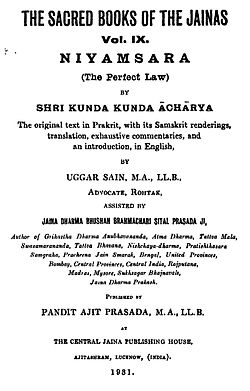Niyamasara
Thank you for being part of the Bharatpedia family! 0% transparency: ₹0 raised out of ₹100,000 (0 supporter) |
| Niyamasara | |
|---|---|
 English translation of Niyamasara | |
| Information | |
| Religion | Jainism |
| Author | Kundakunda |
| Language | Prakrit |
| Period | 1st century B.C. |
| Verses | 187[1] |
| Part of a series on |
| Jainism |
|---|
 |
Niyamasara is a Jain text authored by Acharya Kundakunda, a Digambara Jain acharya.[2] It is described by its commentators as the Bhagavat Shastra. It expounds the path to liberation.
Subject matter[edit]
Niyamasara deals with the three ethico-spiritual standpoints of understanding ultimate Reality – the Nishcaya naya, the Vyavahara naya and the Shuddha Naya.
Niyamasara effectively removes doubts related to Parayayarthika naya and Dravyarthika nayas and elaborates on Vyavahara caritra. He stresses that Vyavahara caritra is based on samyama (self-restraint) and hence rooted in appropriate psychic disposition. He places great emphasis on cleansing the soul of vibhavas, internal impurities, through self-discipline.
A unique feature of the Niyamasara is that Kundakunda characterises both Nichcaya caritra and Vyavahara caritra as tapa, or practice of austerity from their respective nayas. This characterization is based on psychological and pragmatic considerations and if put in practice properly it would lead to internal and external purity and annihilation of the four passions. Kundakunda concludes that Vyavahara caritra and Nishcaya caritra together constitute Samyak caritra. Another unique feature of this text is its description of parama samadhi, not found elsewhere in Jain literature.
Citations[edit]
- ↑ Jaini 1991, p. 33.
- ↑ Uggar Sain 1931, p. 1.
References[edit]
- Jaini, Padmanabh S. (1991), Gender and Salvation: Jaina Debates on the Spiritual Liberation of Women, University of California Press, ISBN 0-520-06820-3
- Uggar Sain (1931), Niyamsara (The Perfect Law), The Central Jaina Publishing House
- Niyamsaar (Niyamasara) in prakrit, sanskrit, hindi and gujarati text in pdf format can be found at
